Community Tip - When posting, your subject should be specific and summarize your question. Here are some additional tips on asking a great question. X
- Subscribe to RSS Feed
- Mark Topic as New
- Mark Topic as Read
- Float this Topic for Current User
- Bookmark
- Subscribe
- Mute
- Printer Friendly Page
Temperature Unit Conumdrum
- Mark as New
- Bookmark
- Subscribe
- Mute
- Subscribe to RSS Feed
- Permalink
- Notify Moderator
Temperature Unit Conumdrum
I'm using Mathcad 15 on a Windows 7 machine. Despite having read this article
I'm still very confused. In the attached file, the first line I would have expected the results to be 80C. However you can see I don't get that answer. I thought I was not understanding temperature units and that still may be the case. I have found, that to get the correct answer, that the equation has to be written and then edited to get the correct answer. So you can see that the two equations give two completely different answers. I was able to get the correct answer by typing 0C and evaluate the answer and then editing to -20C. Do I still not understand units (a question than really can't be answered) or is there some error going on here?
Solved! Go to Solution.
- Labels:
-
Other
Accepted Solutions
- Mark as New
- Bookmark
- Subscribe
- Mute
- Subscribe to RSS Feed
- Permalink
- Notify Moderator
Although it's impossible to tell by looking, your first equation is actually:
-(20°C)+100Δ°C
and your second equation is:
(-20)°C+100Δ°C
note the position of the parentheses.
In the first equation, Mathcad is calculating 20°C and storing the value in the background as 293.15°K, then it applies the negative sign.
Negatives and temperature units are finicky in Mathcad. Maybe other users have suggestions on how to cope.
- Mark as New
- Bookmark
- Subscribe
- Mute
- Subscribe to RSS Feed
- Permalink
- Notify Moderator
Although it's impossible to tell by looking, your first equation is actually:
-(20°C)+100Δ°C
and your second equation is:
(-20)°C+100Δ°C
note the position of the parentheses.
In the first equation, Mathcad is calculating 20°C and storing the value in the background as 293.15°K, then it applies the negative sign.
Negatives and temperature units are finicky in Mathcad. Maybe other users have suggestions on how to cope.
- Mark as New
- Bookmark
- Subscribe
- Mute
- Subscribe to RSS Feed
- Permalink
- Notify Moderator
Thank God there are no tall bridges between work and home today or I might be tempted to jump.
- Mark as New
- Bookmark
- Subscribe
- Mute
- Subscribe to RSS Feed
- Permalink
- Notify Moderator
You may also want to try:

- Mark as New
- Bookmark
- Subscribe
- Mute
- Subscribe to RSS Feed
- Permalink
- Notify Moderator
I'm not sure I see the value in either of these equations. Both lines start with (parentheses implied): -(20°C) = -293.15°K. Despite the fact that it's a temperature below absolute zero, if your intention was to start with that, you would write it as -293.15°K or -566.3°C, not -(20°C).
I believe this is a notational error allowed by Mathcad that is fixed in Prime (Prime forces the use of parentheses).
Have I misunderstood your intention?
- Mark as New
- Bookmark
- Subscribe
- Mute
- Subscribe to RSS Feed
- Permalink
- Notify Moderator
My intention is to find the increase in length of a body when it changes from one temperature to a different temperature.
- Mark as New
- Bookmark
- Subscribe
- Mute
- Subscribe to RSS Feed
- Permalink
- Notify Moderator
This would be my approach (forgive my use of U.S. units):
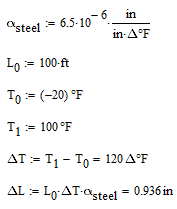
- Mark as New
- Bookmark
- Subscribe
- Mute
- Subscribe to RSS Feed
- Permalink
- Notify Moderator
I see in one NIST reference book - see the picture and attach.
I have asked the author - why do you have F (not deltaF) in thermal conductivity and R (R=F) in specific heat Cp.
The answer was very interesting and I have put it in my new book - Thermal Engineering studies with Excel, Mathcad and Internet
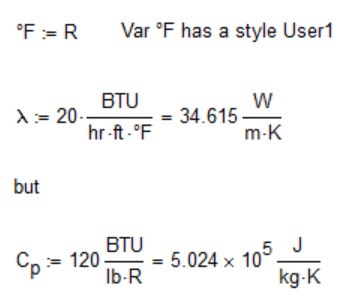
- Mark as New
- Bookmark
- Subscribe
- Mute
- Subscribe to RSS Feed
- Permalink
- Notify Moderator
Sorry, but the correct answer is:
Do not use deltaC - use K
Do not use deltaF - use R
- Mark as New
- Bookmark
- Subscribe
- Mute
- Subscribe to RSS Feed
- Permalink
- Notify Moderator
Valery Ochkov,
Are you suggesting to deal with absolute temperatures only thus avoiding the need to be concerned with the confusing DeltaT units?
Also I see that I misspelled conumdrum. Should be conundrum.
- Mark as New
- Bookmark
- Subscribe
- Mute
- Subscribe to RSS Feed
- Permalink
- Notify Moderator
Andy Stevenson wrote:
Valery Ochkov,
Are you suggesting to deal with absolute temperatures only thus avoiding the need to be concerned with the confusing DeltaT units?
Yes
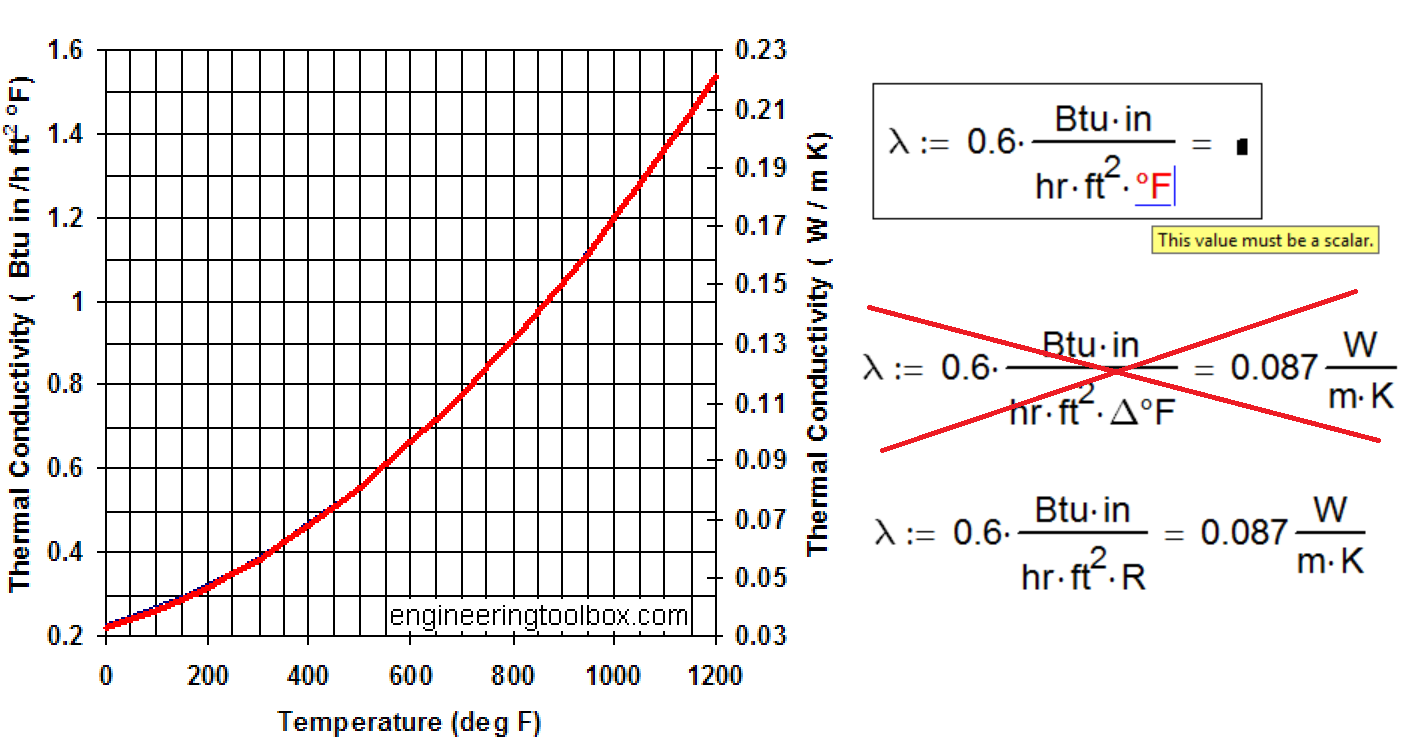
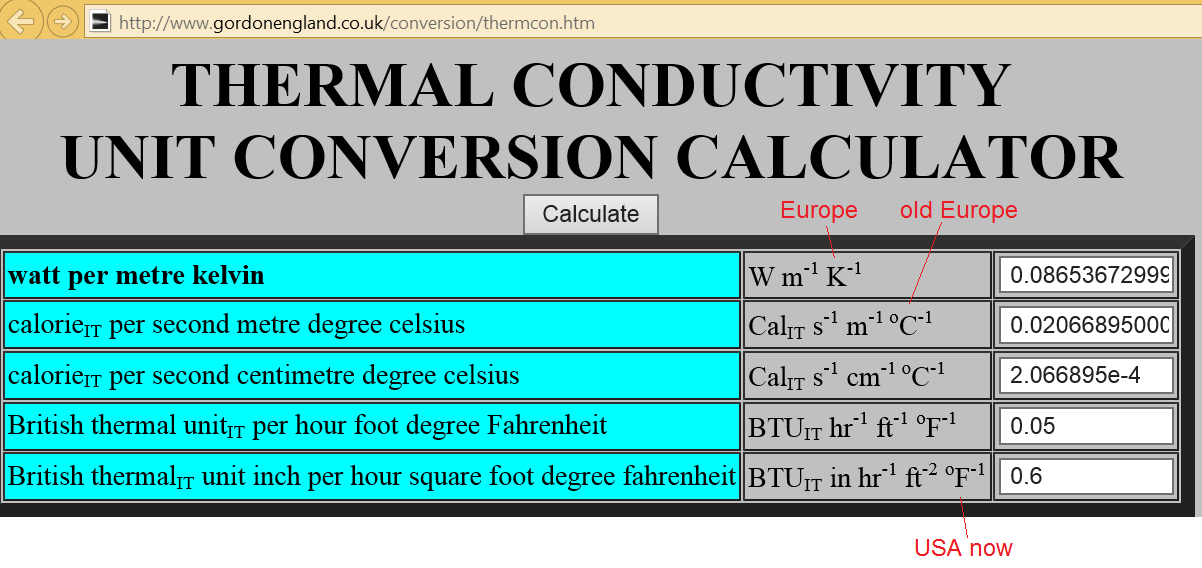
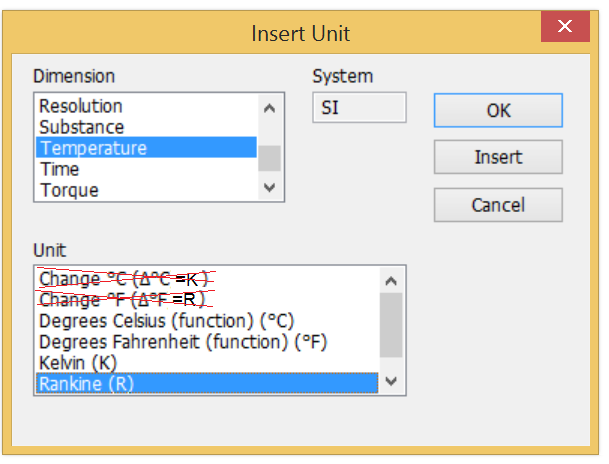
- Mark as New
- Bookmark
- Subscribe
- Mute
- Subscribe to RSS Feed
- Permalink
- Notify Moderator
Valery,
I'm not sure I see what the problem is with using ΔF instead of R. In your example, the second equation (X'ed out in red) uses ΔF and the result is the same as your last equation which uses R.
I'm not familiar with thermal conductivity, but I assume the equation is inversely proportional to the change in temperature. Thus, it makes sense to me that your first equation results in an error.
-Mark
- Mark as New
- Bookmark
- Subscribe
- Mute
- Subscribe to RSS Feed
- Permalink
- Notify Moderator
If we have delta_C and delta_F we must have delta_m, delta_kg etc
- Mark as New
- Bookmark
- Subscribe
- Mute
- Subscribe to RSS Feed
- Permalink
- Notify Moderator
You're welcome to define them if you'd like. However, since 0m = 0ft = etc., it is not necessary.
Since 0F ≠ 0C ≠ 0K, it is necessary to distinguish between a temperature measurement (e.g. it is 40F = 4C outside today) and a change in temperature (e.g. it was 40F = 22C warmer a few months ago).
- Mark as New
- Bookmark
- Subscribe
- Mute
- Subscribe to RSS Feed
- Permalink
- Notify Moderator
We have four temperature scales - Celsius, Fahrenheit, Kelvin and Rankine.
We have at least two scale heights - from the level of the North Sea and the Mediterranean Sea.
We have at least two time scale - about creation of the world and the birth of Christ.
Therefore we can have not only delta_C and delta_T, but delta_m and delta_sec ![]()
- Mark as New
- Bookmark
- Subscribe
- Mute
- Subscribe to RSS Feed
- Permalink
- Notify Moderator
What you say is true. However, Mathcad does not include any of the height (elevation) scales or time scales that you list. Therefore, Mathcad has no need to include conversions between the scales.
- Mark as New
- Bookmark
- Subscribe
- Mute
- Subscribe to RSS Feed
- Permalink
- Notify Moderator
Mark Gase wrote:
What you say is true. However, Mathcad does not include any of the height (elevation) scales or time scales that you list. Therefore, Mathcad has no need to include conversions between the scales.
We can create users height or time scales.
I newer see delta_C or delta_F in any reference book.
- Mark as New
- Bookmark
- Subscribe
- Mute
- Subscribe to RSS Feed
- Permalink
- Notify Moderator
If you can create user-defined height or time scales, can you not also create user-defined delta units?
I agree that I never see ΔC or ΔF in any reference books, but I can't say that I regularly reference books that automatically convert units for me either. ![]()





